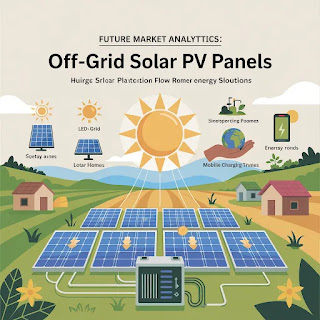The Expanding Horizon of Off-Grid Solar PV Panels: A Market Poised for Transformation
The off-grid
solar photovoltaic (PV) panels market represents one of the most promising
frontiers in renewable energy, offering sustainable electricity solutions to
communities and applications beyond traditional grid infrastructure. As we
navigate through 2025, this sector stands at a critical juncture, balancing
tremendous potential with significant investment challenges.
Explore the full report - https://futuremarketanalytics.com/report/off-grid-solar-pv-panels-market/
Market Growth and Current Landscape
The off-grid solar PV panels market is expected to reach
$4.46 billion by 2029 with a compound annual growth rate (CAGR) of 9.5%,
demonstrating robust expansion prospects. This growth trajectory reflects
increasing global recognition of off-grid solar as a viable alternative to
traditional energy infrastructure, particularly in remote and underserved
regions.
Market capacity is projected to grow from 12.23 gigawatts in
2025 to 17.42 gigawatts by 2030, with a CAGR of 7.32%, indicating substantial
scaling of installations worldwide. This expansion is driven by technological
improvements in panel efficiency, battery storage solutions, and decreasing
system costs that make off-grid solar increasingly competitive.
The Investment Challenge
Despite promising growth projections, the sector faces a
significant funding gap. Recent analysis warns that a 6-fold increase over
current investment levels—approximately $21 billion—is required to realize
off-grid solar's potential to contribute to universal energy access. This
investment shortfall represents both a challenge and an opportunity for
stakeholders seeking to capitalize on the growing demand for distributed energy
solutions.
The urgency of this investment need becomes clearer when
considering the market's potential impact on global energy access. Off-grid
solar systems could provide first-time electricity access to almost 400 million
people globally by 2030, transforming lives and economic opportunities in
previously underserved communities.
Market Drivers and Applications
The off-grid solar PV market benefits from several key
drivers that distinguish it from grid-tied installations. Remote residential
applications, commercial facilities in isolated locations, and emergency backup
systems represent core market segments experiencing steady growth. The off-grid
segment is expected to showcase more than 8% CAGR through 2034, driven by
growing demand for renewables across regional peripherals.
Agricultural applications have emerged as a particularly
strong growth area, with farmers adopting off-grid solar for irrigation
systems, livestock operations, and crop processing facilities. Additionally,
the telecommunications sector continues to invest heavily in off-grid solar
solutions to power remote cell towers and communication infrastructure.
Technological Advancements and Cost Reductions
The market's growth trajectory is supported by continuous
technological improvements in both solar panel efficiency and energy storage
systems. Modern off-grid installations benefit from advanced battery
technologies, smart inverters, and monitoring systems that enhance reliability
and performance. These technological advances have contributed to significant
cost reductions, making off-grid solar increasingly competitive with diesel
generators and other traditional power sources.
Manufacturing scale-up and supply chain optimization have
further accelerated cost improvements. The proliferation of PV panel
manufacturing companies along with growing solar PV capacities is expected to
drive market expansion, creating positive feedback loops that benefit end users
through improved affordability and system performance.
Future Outlook
The off-grid solar PV panels market stands at an inflection
point where technological maturity meets growing global demand for clean,
distributed energy solutions. While investment challenges remain significant,
the sector's strong growth fundamentals and expanding applications suggest
continued expansion. Success in bridging the funding gap could unlock
transformative potential for energy access, economic development, and
environmental sustainability across underserved markets worldwide.
As the market evolves, stakeholders who recognize and act
upon current opportunities while addressing investment and infrastructure
challenges will be best positioned to capture value in this dynamic and
socially impactful sector.




Comments
Post a Comment